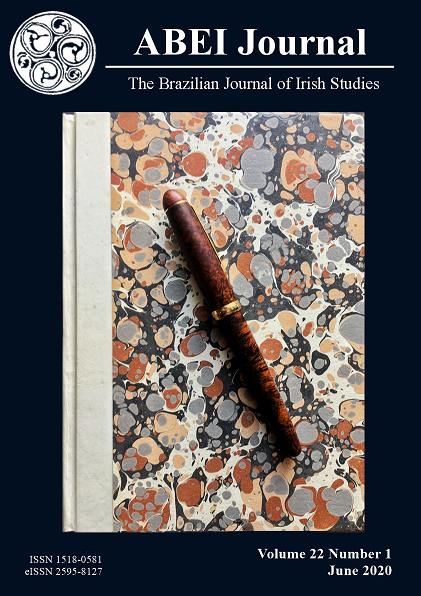A Poética da “Invencão Pura”: Ghosts, de John Banville
DOI:
https://doi.org/10.37389/abei.v22i1.3851Palavras-chave:
Ghosts, Invenção pura, Pinturas, Intertexto, Narrativa, VaublinResumo
Este ensaio argumenta que Ghosts (1993), de John Banville, pode considerado o romance mais tecnicamente inventivo de Banville, repleto de níveis ontológicos com diversas camadas que trazem, repetidamente, seu discurso diegético primário em comunhão com outras formas artísticas – música, pinturas, estátuas, bem como uma saturação narrativa com outros antecedentes literários que excedem qualquer coisa encontrada em outro lugar em sua obra. Ghosts demonstra uma camada implícita de níveis dialéticos que são, de fato, uma encenação narrativa da teoria dos múltiplos mundos que tanto fascinam muitos dos narradores de Banville. Em nenhum outro lugar ele gera um modelo tão abrangente de um sistema ontológico com diferentes níveis que se cruzam tão propositadamente quanto em Ghosts. Este ensaio mapeia uma topografia do que é efetivamente uma variante fictícia sofisticada da teoria científica de múltiplos mundos em Ghosts, e oferece algumas perspectivas sobre a importância desse modelo estético.
Referências
Banville, John. “A True Picture of Picasso,” Irish Times, January 4, 2014, http://www.irishtimes.com/culture/books/a-true-picture-of-picasso-1.1642473 (accessed June 1st, 2020).
Bryson, Norman. Word and Image: French Painting of the Ancien Régime. Cambridge: Cambridge University Press, 1981.
heeke, Stephen. Writing for Art: The Aesthetics of Ekphrasis. Manchester: Manchester University Press, 2008
Hertel, Ralf. “The eye in the text: John Banville’s Frames (1989-1995)”. Making Sense: Sense Perception in the British Novel of the 1980s and 1990s. Amsterdam/New York: Rodopi, 2005.
Kenny, John. John Banville. Dublin: Irish Academic Press, 2009.
________. “Well Said Well Seen: The Pictorial Paradigm in John Banville's Fiction.” Irish University Review, Vol. 36, No. 1, Special Issue: John Banville (Spring - Summer,2006)
Lessing, G.E. Selected Prose Works of G.E. Lessing. Ed. Edward Bell, trans. E.C. Beasley and Helen Zimmern. London: G. Bell, 1879.
McHale, Brian. Postmodernist Fiction. London: Routledge, 1996.
McKeon, Belinda. “John Banville: The Art of Fiction No. 200,” The Paris Review, no. 188, Spring 2009, http://www.theparisreview.org/interviews/5907/the-art-of-fiction-no-200–john-banville (accessed June 2, 2020)
Meany, Helen. “Master of Paradox: Interview with John Banville.” The Irish Times (March 24, 1993): 12.
O’Connell, Mark. John Banville’s Narcissistic Fictions. London: Palgrave Macmillan, 2013.
______. “The Empathic Paradox: Third-Person Narration in John Banville’s First-Person Narratives” in Orbis Litterarum 66:6, (2011).
Schwall, Hedwig. “An Iridescent Surplus of Style: Features of The Fantastic in Banville's The Infinities”. Nordic Irish Studies, Vol. 9 (2010).
______. “An Interview with John Banville,” European English Messenger 6, no. 1 (1997).
Smith, Eoghan. “It’s That Man Again,” Dublin Review of Books, no. 83 (November 2019).
Steiner, George. Grammars of Creation, London: Faber & Faber, 2001.
Timmerman, Michelle B. “15 Questions with John Banville.” Interview. The Harvard Crimson, February 26, 2010, http://www.thecrimson.com/article/2010/2/26/fm-jb-think-work/ (accessed 31 Oct, 2019).
Wallace, Arminta. “‘I’m at Last Beginning to Learn How to Write, and I Can Let the Writing Mind Dream,’” in The Irish Times, June 30, 2012, http://www.irishtimes.com/culture/books/i-m-at-last-beginning-to-learn-how-to-write-and-i-can-let-the -writing-mind-dream-1.1069902 (accessed May 28, 2020).
Weretka, John. “The Guitar, the Musette and Meaning in the fêtes galantes of Watteau,” EMAJ: Electronic Melbourne Art Journal, no.3 (2008): https://emajartjournal.files.wordpress.com/2012/08/weretka.pdf (date accessed 23 April 2016).
Downloads
Publicado
Edição
Seção
Licença
Copyright (c) 2020 Neil Murphy

Este trabalho está licenciado sob uma licença Creative Commons Attribution-NonCommercial 4.0 International License.


